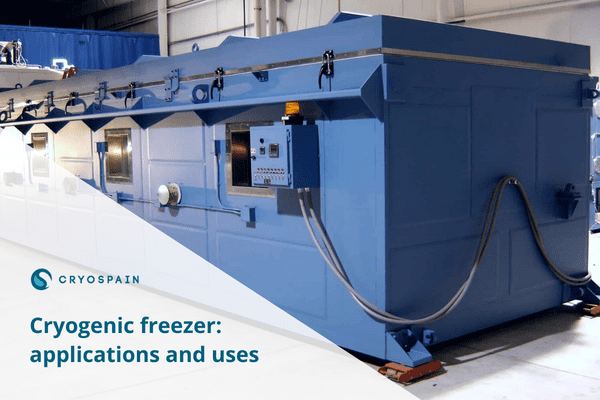The cryogenic freezer is a type of equipment or device that is in charge of generating extremely low temperatures (cryogenic) in order to freeze certain materials or substances.
Generally speaking, cryogenic temperatures range between -150°C and -273°C, values at which the chemical properties of gasses change. In order to produce such an environment, and as we’ll see below in this article, it employs different techniques that differ from the more conventional mechanical freezing processes.
Keep reading to find out how a cryo freezer works, the different types of system and what sort of advancements this equipment is facilitating today across the different industries.
Cryogenic freezer types and their applications
The different types of cryogenic freezer coincide with the different ways in which these systems can work.
As such, it’s possible to differentiate between:
- A cryo freezer that works through crystallized preservation. This equipment functions by spraying liquid nitrogen in a sealed tank. As the nitrogen vaporizes, it’s able to absorb heat and remain on the surface of the frozen material in the shape of tiny crystals. This method is specially advisable for food preservation, as it allows to retain qualities such as flavor, texture and moisture. This is also known as a freezer that uses liquid nitrogen, or an LN2 freezer.
- Cryogenic freezers can also follow a fast-freezing model without compromising the preservation of delicate biological materials or samples.
Additionally, depending on the actual shape that the cryogenic freezer takes, it’s possible to differentiate between cabinet freezers, individual modules, tunnel or spiral-shaped equipment, among other options.
The following include some of the key applications of the cryo freezer today:
- Manipulate high-end metal products
- Scientific experiments regarding tissue samples
- Preserving vaccines
- Rocket fuel
- Freeze fresh food products
Keep reading: Applied cryogenic technologies in the industry
Cryogenic vs. Mechanical Freezers
One can summarize the differences between both systems as follows:
Cryogenic freezer
A works by using a cryogenic liquid (such as liquid hydrogen) to act as a spray or immersive liquid. This generates an almost instant freezing process.
This equipment requires lower initial capital costs than other industrial mechanical freezer options. Higher investments will be related to acquiring refrigerant substances.
It’s essential to maintain and secure it to ensure safety, including implementing proper ventilation measures. Choosing it is usually the right option for installations facing space limitations or requiring products to retain their individual configuration when frozen (for example, peas).
Mechanical freezing
On the other hand, refers to the more conventional or standard method for refrigerating materials and substances. Common refrigerators for this model involve ammonia or carbon dioxide.
Mechanical freezing typically incurs higher initial capital costs and is generally recommended for freezing requirements in high-volume productions.
Industrial uses of cryogenic freezers
Cryogenic freezers are used across a wide range of industries. this includes the medicinal and pharmacy sectors, which are increasingly adopting cryogenic equipment for medicinal gasses and preserving blood and tissue samples, among other applications.
Additionally, the food sector represents a key player in the need for cryo freezers today.
Cryogenic Food Freezing
Fresh product storage and transport today relies of cryogenic freezers to extend the life of products and guarantee they maintain their quality, nutrients and external appearance.
Additionally, the use of cryogenics allows companies to minimize dehydration in their products, preserve their flavor, textures and colors and avoid individual pieces from being frozen together. This is because, as we’ve seen above, a LN2 freezer is able to generate smaller crystal pieces than conventional, mechanical freezing processes.
Applied during the final production stages of food processing and packaging, cryogenic freezers are thus facilitating companies who look for maximum efficiencies without compromising their food product’s qualities.
Related content: What are food gases and which are the main ones?
Want to find out more? At Cryospain, we share our two-decade expertise in cryogenic engineering to design, manufacture and implement the right cryogenic equipment for our clients. Get in touch with us and talk to our team to see how we can help you.











 Contacte-nos
Contacte-nos